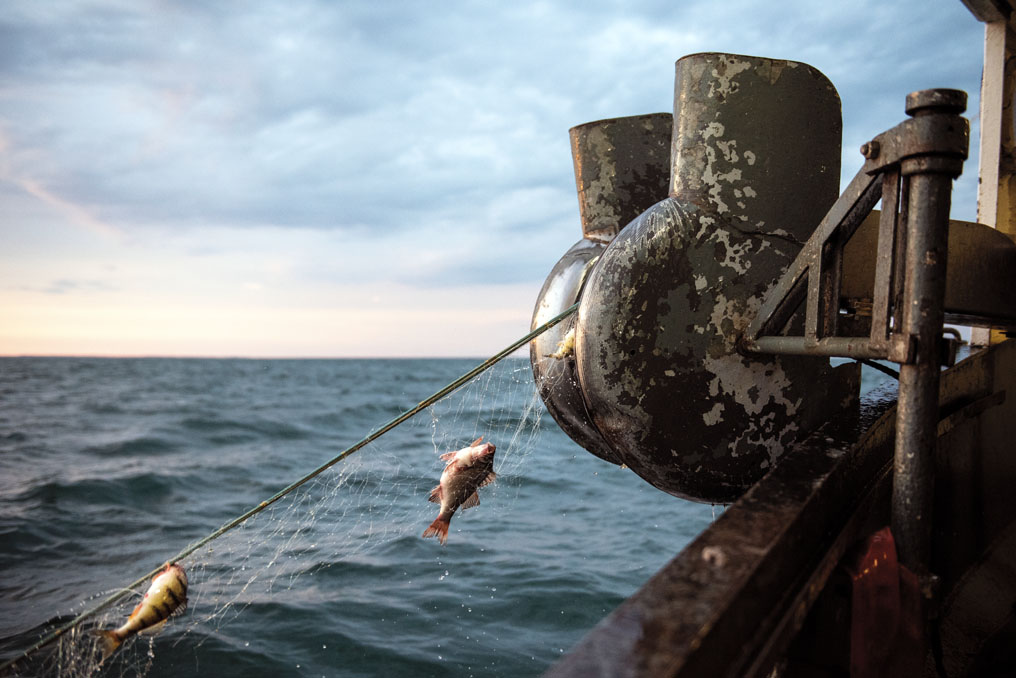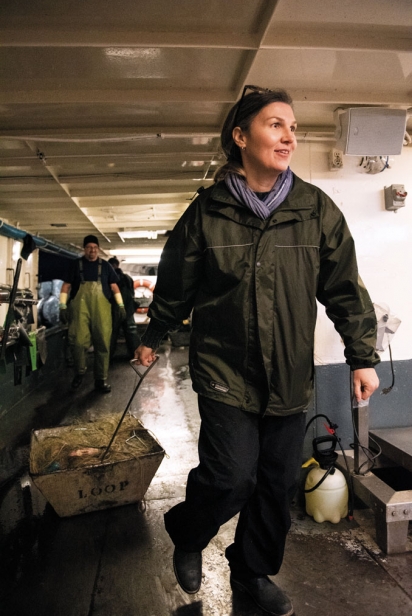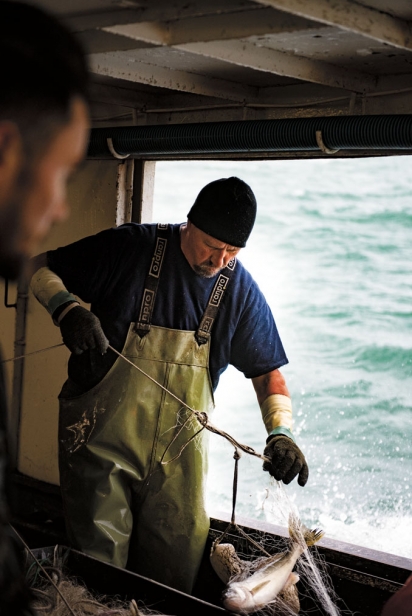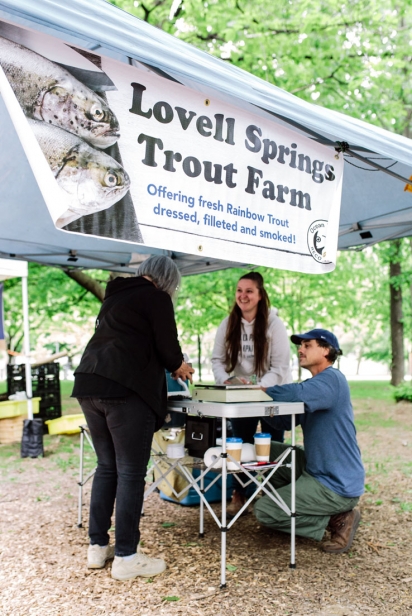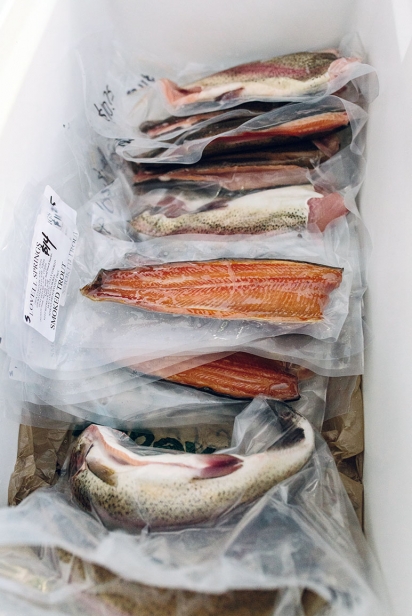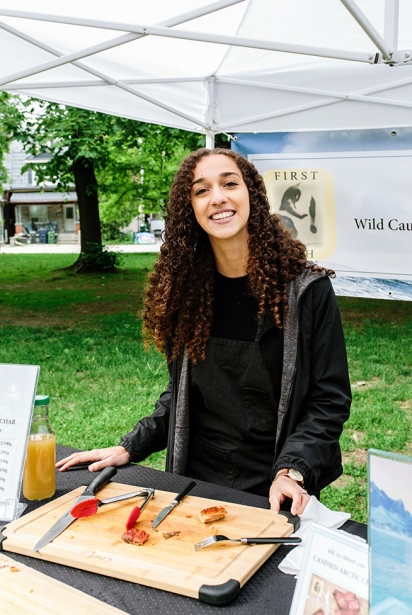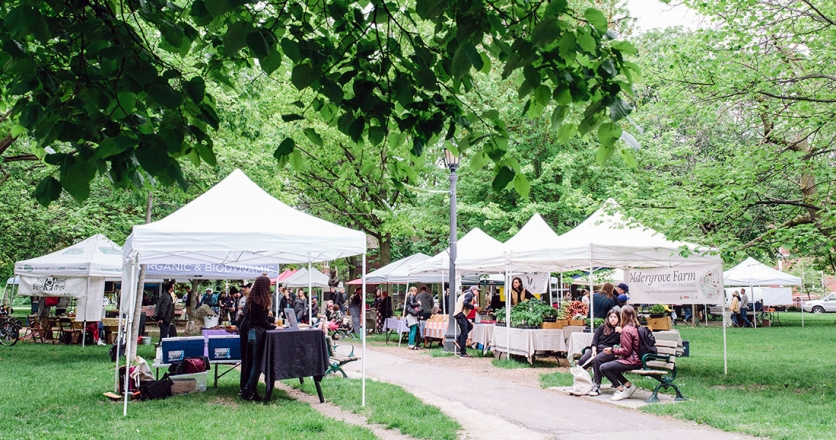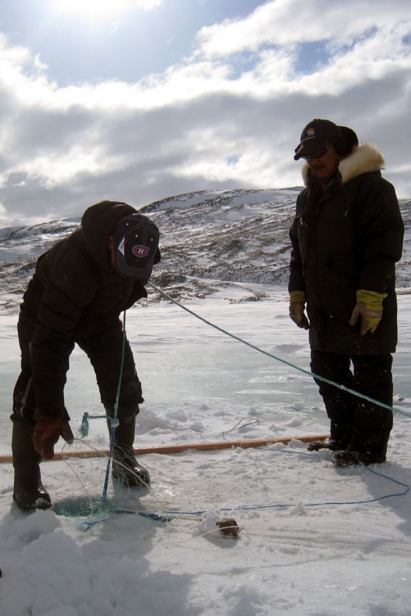A Tale of Three Fish
RISING TO THE BAIT
Jennifer Johnston went in hook, line and sinker to build a Canadian seafood business with a difference.
Any fishmonger who is worth her weight in sea salt and curious about her own supply chain should find herself, at least once in her life, aboard a vessel on the hunt for fish.
A few weeks back, Jennifer Johnston, owner of seafood vendor Fisherfolk in Toronto, spent a few hours aboard captain Todd Loop’s Lake Erie fishing boat on the prowl for yellow perch and pickerel.
“I’d worked up the courage — and survived without even a momentary bout of seasickness,” she recalls.
As a novice, she was impressed with the competence displayed by the professionals on the boat. “They really know what they’re doing, so I think I can safely remain on land, though I’ll probably go out on the water at least a few more times.”
Her day on the water gave Johnson a sense of the process that begins with fishing itself and ends with her transactions with quality-conscious customers in her now booming Toronto premises. “I was honoured to be welcomed aboard,” she recalls.
Today is a Friday — as always, a day of madness at Fisherfolk’s headquarters in the east end of the city. It’s early, but all hands are on deck as staff work hard to prepare for a busy farmers’ market day ahead. They off load deliveries of fresh and frozen seafood from Fisherfolk’s two vehicles and cart them through the back doors into the kitchen — also known as the fish locker — for processing, portioning and packaging. They weigh and vacuum-seal delicate fillets of Lake Erie yellow perch, naturally plump Digby sea scallops and the tiniest, sweetest North Atlantic shrimp, as they label, invoice and send completed orders to chefs and markets across the Golden Horseshoe.
The gleaming steel door to the walk-in cooler swings open and Johnston appears with a 40-pound halibut slung over her shoulder. The greenish-grey flatfish thuds against the stainless- steel table, where it waits for Johnston to sharpen her scimitar- like knife before breaking it down into sellable cuts. There’s a fair bit of hacking involved, but she wields the knife with precision and abandon, which pretty well describes how this landlubber navigates the choppy waters of the competitive Canadian seafood business.
Early on, none of this seemed to be her destiny. In 2001, Johnston graduated from a graphic-design course at George Brown College, but she never used her hard-won degree. “I kind of wandered a bit, working in retail and the restaurant business for several years,” she explains. “But I truly didn’t feel the passion until I started connecting with farmers and local food artisans.”
Her fishmongering beginnings were small. In 2009, with zero experience in the fish business, no capital and 10 pounds of Nova Scotia haddock in hand, she took a stand at Scarborough’s Birchcliff farmers’ market. “I sold out that day,” Johnson recalls. “People were very excited by the quality and direct connection to the fishermen and the product.”
Johnston was drawn to fish and seafood, though it offers more challenges than selling local cheeses or shelf-stable goods. “I didn’t have any personal or family background in fishing, but I noticed there wasn’t much local fish at the farmers’ markets,” she says. “It seemed there was a story to tell and a product to provide.”
From that day on, it’s been almost all sweat equity, but with an overall upward trajectory. Johnston incorporated in 2010, signed the lease for her warehouse on Northline Road in 2012 and expanded into the attached retail space in 2016.
A decade after that first farmers’ market sale, she moves upwards of 200 pounds of fish on a typical market day.
Commercially, she’s in a good place, but the path to getting there had its share of hard turns and rough rides.
“Everything has been challenging. Running any business is tough, but I just went all-in with a mix of passion and good old-fashioned hard-headedness, discovering the issues as I went along,” Johnston says. “It’s tough to find people who are as passionate as I am.”
At 43, Johnston is five-foot-seven and impressively fit-looking. Good thing, because she needs strength for all the heavy lifting that falls on her shoulders. “This business is very physically taxing. I had to move an 80-pound swordfish once, and that was backbreaking,” she recalls. “Sixty-pound boxes are pretty typical.” Not surprisingly, she's let her gym membership lapse.
Margins in the food business are slim, she goes on to say, and running a bricks-and-mortar shop to boot means unforeseen costs are commonplace. For Johnston, who had no experience running a business, everything was trial and error.
But help comes through the connections she has made with fishers, including East-Coaster Stacey Symonds, with whom she’s had a business partnership since 2009. “I started the business solo, but I’ve worked with him nearly from the beginning to bring some of my whole fish from Nova Scotia. Stacey is there and can spend time on the boats and has many family connections [to fishers]. So that is where the intention of staying as close to the source as possible spring-boarded from.” She adds that she tries to visit the fisherfolk who supply her a couple of times a year. “They’re some of the best people I have come across. They understand the fragility of our primal resources and there is a real humility there.”
It goes without saying that Johnston sources sustainable fish, but she practically bristles at the buzz word.
“There is no clear definition of ‘sustainable’ as it relates to seafood, and it’s just one of those words that’s overused," she says. "Basically, you can brand something sustainable that is shipped in from halfway across the world, from a place with completely different practices and put it next to something from Canada and use the same word.”
If her own use of the word “sustainable” excludes some officially “sustainable” products, Johnston is unapologetic. “You don’t rely on other people to tell you what to think,” she says. “Every fishery’s story is different and has its own challenges. There are lots of nuances. What I think is important is taking the time to understand the complexity and then decide for yourself how you define sustainable.”
What is undeniably sustainable is Johnston’s nose-to-tail approach. Waste is minimized. Heads and bones are simmered into fumet — the essential fish stock that is the base of her popular chowder. Meaty off-cuts become, with finessing, burgers, kebabs and fish pie.
Johnston still does four markets a week — Evergreen Brick Works, The Stop's Farmers' Market at Wychwood Barns, Guelph Farmers’ Market and Withrow Park — and supplies retails stores, including Fresh City Farms, Fresh from the Farm and Karma Food Co-op.
With help from her husband, mother, daughter and son, Fisherfolk is a family business in the truest sense of the word.
“I’m the owner, but everyone in the family is committed to the success of Fisherfolk,” she says, adding that her children and husband all help out during market days. In some ways, running a business is hard on family life, with little “family time” to be had. “They are tremendously supportive and have helped me a lot,” Johnston says. “Without their blessing and support, what I’m doing would not be possible.”
Passion, and a willingness to make certain sacrifices for great seafood, is something Johnston’s loyal customers display as well. “I have customers who have been with us since the beginning and share our passion. If not for them, we couldn’t have gotten to where we are now.”
When asked why customers should prefer Fisherfolk to alternate vendors, Johnston says, “Our story speaks for itself. We don’t consider ourselves just a fish shop. The people who purchase our product have a connection with us and to the people who fish.
“It’s all about a feeling and a way of life that are connected by the top-quality product you find on your plate.”
Fisherfolk
90 Northline Rd., Toronto, Ont.
fisherfolk.ca| 416.562.8819 |@fisherfolk
RAINBOW TROUT LIKE NO OTHER
A deadly fish allergy is no problem for a man raising and selling sustainable rainbow trout.
Sean Lovell really loves fish. The proprietor of Lovell Springs Trout Farm enjoys watching them grow, starting as eggs, hatching as alevin, morphing into fry and maturing into full- grown rainbow trout with their tell-tale red cheeks and stripe.
Here’s the catch, though: Lovell, who has built a career on raising rainbow trout just outside Port Dover to sell fresh and smoked is deathly allergic to freshwater fish. His allergy is so severe he has to wear a face mask when he harvests and fillets his trout.
Lovell’s chief taste-tester and life partner Jess Bauman scrupulously brushes and flosses after sampling the fish Lovell sells at Toronto farmers’ markets and to local restaurants, lest the couple shares a moment of affection that could send Lovell into anaphylaxis.
And yet, raising fish to eat was what Lovell chose to do when he was laid off from his corporate finance job with a spirits producer and distributor in Windsor in 2006. Lovell, who had aquariums growing up and fished with his father as a boy — becoming well aware of his allergy during shore lunches — started researching fish farming before he was given his pink slip.
“I wanted to be my own boss and live in the country. I didn’t like the finance industry where people stab you in the back,” Lovell says.
So, he chose one that could kill him instead. “I just like fish,” Lovell says with a shrug. “I had no idea (it was profitable). I just wanted a fish farm. I’ve never eaten one.”
Still, he knows they taste good. Bauman can confirm. But the very nature by which Lovell produces rainbow trout sets his fillets apart from the vac-packed, bright pinky-orange versions found at the neighbourhood supermarket.
It goes back to when hen he lost his job 13 years ago. Lovell’s search for property brought him to Norfolk County on the northern shore of Lake Erie, and more specifically to the burg of Vittoria, population 600.
An old chicken farm had come up for sale. But it was more than the house, the size of the swath or that it is sandwiched between two pristine conservation areas that sold Lovell — it was the 10 natural springs channeling “sweet water” through the property. The artesian water the springs provide is soft, has the ideal amount of dissolved minerals for proper fish growth, a stable pH and it flows 365 days a year, remaining at a constant 10C, even in the dead of winter. It would feed the raceways Lovell would build for his trout and carry natural aquatic food sources, including tiny freshwater shrimp, to his schools to supplement the feed he would give them.
The crystalline water that one could drink straight from the source does wonders for his fish, but so does Lovell’s approach to raising them — a process that takes three years. It’s the antithesis of any get-rich quick scheme.
Lovell grows his fish from eggs. He uses his brood stock, milked for eggs and sperm, for spawning in late fall. The eggs are kept indoors in an incubator that’s fed a continuous flow of spring water, but not the industry-standard formaldehyde drip to prevent the spread of deadly infection caused by any bad eggs.
Instead, Lovell, like a helicoptering mother hen, checks on his spawn every few hours, picking out those eggs that die or aren’t fertilized. Weeks later, usually by New Year’s, they hatch and the alevin, still carrying the yolk sac for nutrition, are moved to a tank roughly the size of a bathtub where they morph into fry. As they mature, the fish move to roomier tanks until they’re big enough to live outdoors in two long, impeccably clean raceways where they’re fed twice a week and given time to grow to market size.
It takes three years to raise a fish for market — to about 1.5 pounds — “because we don’t force feed the fish,” Lovell says.
The proof is in the appearance of the fillets with their ultra-fine streaks of white fat, hairlines compared to the more pronounced threads woven into the flesh of imported and mass-farmed varieties. They’re leaner, more protein-rich; helped along by Lovell’s use of low-fat, high-protein feed and the natural aquatic and terrestrial insects that make up a quarter of the trout’s diet.
Some consumers mistake the white lines in trout for stores of heart-healthy Omega-3 fatty acids. They assume the more pronounced they are, the better. But those good fats are found in the thin dark layer of flesh just under the fish’s skin and there’s plenty of that nutritious dark meat on a Lovell Springs fillet. Lovell refuses to use hormones, steroids, antibiotics or other chemical interventions on his Ocean Wise-recommended fish. At most, he treats any issues with salt, a natural antidote to pathogens, he explains.
Lovell sold his first fillet — fed, caught and processed by hand — on Jan. 1, 2009, and knew he was onto something.
He has loyal supporters at Trinity Bellwoods Farmers’ Market, where shoppers scoop up 250 pounds of fresh and hot-smoked, hand-filleted fish each week. Every package bears a simple label with the date it was processed, smoked or packed and a best before. Fillets are also available for sale at Bauman’s family’s farm and Matz Fruit Barn in Port Dover, which uses Lovell’s fish waste as fertilizer. Local high-end eateries, including The Combine in Simcoe and David’s Restaurant in Port Dover, also rely on Lovell for trout that’s never frozen and delivered within 24 hours of harvest.
It works out to sales of about 30,000 pounds — or 30,000 fish — a year. That’s as big as Lovell wants to go before the scale tips toward factory farming and quantity puts undue pressure on quality.
“We want to be known for this type of fish — when people say, ‘We want clean fish,’” he says. “I don’t want to be a factory farm. There’s a lot of research that went into this and we’re the only ones who do fish like this.”
Lovell Springs Trout Farm
At Trinity Bellwoods Farmers' Market | 226.567.3474
FIRST FISH
How buying great fish in Toronto is helping create jobs for communities at the top of the world.
Everyone knows what happens when you teach a man to fish. But what about when you help a community build an entire fishery? Mike Labbé and his daughter Mickayla are in the process of writing that proverb.
They’re doing it as First Fish, a social enterprise based on sales of wild-caught Arctic char and turbot from Nunavut, an idea that came to be when Mike was tapped in 2016 to help solve an affordable housing crisis in Iqaluit.
“It’s been a long journey,” Mike says. Mike heads up Options for Homes and Options International, a Toronto-based non-profit condominium developer he founded to build homes for low- and middle-income families in Africa and Toronto.
The organization’s goal is home ownership for people who are typically priced out of the market. Nunavut has plenty of communities needing housing. But after a week in Iqaluit, Mike realized housing was difficult to set up and there wasn’t a lot of development happening. He was then invited to the remote hamlet of Qikiqtarjuaq, situated off eastern Baffin Island, dubbed Qik (pronounced Kick) for short, but encountered other challenges there. Unemployment in the community of 600 was a whopping 60 per cent.
“We can’t really provide housing when unemployment is that high, so we needed to improve employment,” Mike says.
So he traded his home builder hat for that of job builder, tapping into the economic development potential of harvesting wild Arctic char and turbot, a white fish with dense flesh like halibut. Qik remains one of the few undervalued fisheries left in the world in a place so far atop the globe, the Northern Lights are known as the Southern Lights.
Mike looked to his hometown of Toronto for a market and First Fish was born. He would serve as a director for the social enterprise; Mickayla would handle marketing and sales. All of it would directly support the Inuit fishermen with whom they worked.
But first, to catch those fish. In the Arctic, it’s not as simple as dropping a line in the water. First Fish’s Inuit fishers rely on traditional knowledge and legendary skills to net their catch. More specifically, they need an auger to drill through up to eight feet of ice in the winter, creating two holes and a net system between both. It’s not easy, but the rewards are thousands of pounds of char, well within the current quota of 60-thousand pounds allowed for Qik and 250-thousand pounds for nearby Pangnirtung. First Fish pays more than the local price for each catch, ensuring a fair, liveable wage for its fishers.
“These are some of the strongest, smartest fishermen on the planet and they go unnoticed,” Mike says.
The turbot, which has a quota of 500-thousand pounds in Qik and one-million pounds in Pangnirtung, is line-caught up to one kilometre down, with no bycatch (unintended fish and species catch) and no damage to the Arctic Ocean floor.
Being wild caught in the pristine waters of the Arctic makes First Fish char and turbot different than most farmed alternatives. The colder water makes the fish oilier, loaded with beneficial Omega-3 fatty acids, Mike notes, yet because they’re wild, they have less body fat, giving fillets a smoother taste. “If you like smoked salmon, you’ll notice the extra oil with char,” he says.
The idea was to process and smoke the fish locally, creating more jobs all the while, then ship the finished product south. The means weren’t there in Qik, so after some searching, the social enterprise found Japan Fish in Toronto to do the filleting and Smoke Bloke to hot and cold smoke some of the char. (The turbot isn’t smoked.)
“The beauty of Arctic char is it’s oily fish, so you can freeze it and you don’t have any reduction of quality,” Mike said about the logistics of getting the catch to the big city.
Last year was First Fish’s inaugural season selling its catch to Toronto restaurants and at three of the city’s farmers’ markets — Evergreen Brick Works, Trinity Bellwoods and Wychwood Barns.
Six thousand pounds of fresh-frozen and smoked fish were snapped up in six months by market-goers and the kitchens at Nish Dish, Tea-n-Bannock and Canoe, among others. But just as business picked up, First Fish hit a snag: it needed more fish, and a steady supply, which its primary fishers in Qik couldn’t always guarantee because of other obligations.
Nearby, the community of Pangnirtung on Baffin Island boasted a processing plant and more fishers to help. Fishers from Qik could send their catches to Pangnirtung, too, to be cleaned and filleted before heading south to Japan Fish for portioning.
The connection to “Pang” and its processing plant came the potential for even greater impact, Mike adds.
First Fish has ordered 45-thousand pounds of catch over the next five months and increased its presence to nine Toronto farmers markets this year, including Sorauren and Leslieville.
“Up until now, the effect has been modest. We had three fishermen in Qik and a couple of jobs in Pang,” he says. “If the company can supply [45-thousand pounds], that would create 17 new jobs."In other words, “a job for everyone who wants to work,” he note
There are currently 250 people looking for work in Pangnirtung. Sixty per cent of surplus money First Fish makes from sales in Toronto goes back into building and sustaining the northern fishery directly, while the other 40 per cent is invested into other supports for the Indigenous communities. The goal is to achieve full employment within four to five years, moving 500-thousand pounds of fish a year at markets and through smaller, high-end distributors, all in a way that takes into account the wisdom and knowledge of local fishers.
There are enough fish to do it, Mike notes. First Fish catches are far below the quotas set by Fisheries and Oceans Canada, which are even more closely monitored by the community elders, who direct fishers on when and where to harvest based on what they see as the state of stocks.
Ten per cent of what’s caught also goes into a community freezer to feed the people of Pangnirtung and Qikiqtarjuaq.
“It’s just a matter of matching the amount of fish and how much is
processed with what we can sell down south,” Mike explains. “The goal is to sell more and more filleted fish so the unemployment rate goes down. They have enough quota on the island to meet the employment demand.”
And the hunger down south, where First Fish is building its market with a remarkable goal and story is enough to sustain those jobs up north.
“Our goal is not to create a profit,” Mickayla says. “It’s to support communities up there. Obviously, people love the quality of fish because we have repeat customers. People are coming to farmers’ markets trying to escape from farmed fish in stores, and they’re very happy they have an alternative.”
First Fish
478 Queen St. E. Suite 201, Toronto, Ont.
firstfish.ca | 416.504.9855 x221 | @firstfishca


